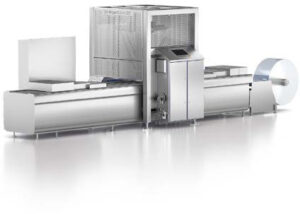SAFE USE OF ROBOTS


SAFE MACHINE INTERLOCKING PROTECTS AGAINST ACCIDENTS IN HYGIENE-SENSITIVE LOCATIONS
In the SAC Loader, Singer & Sohn GmbH has developed a compact, flexible and powerful system for the packaging of food items – a truly multi- talented insertion robot. One of the challenges faced by its design team was the safeguarding of the hazardous area under hygienic conditions.
Singer & Sohn, a family-run business now in its second and third generations, has been famed as a manufacturer of systems for the packaging, temperature control and handling of food items for around three decades.
Representative Christian Singer explains the company’s focus: ‘We focus solely on the food industry. Some 50 to 60 per cent of our systems are used in meat processing and sausage making. The rest is devoted to baked goods, fish, confectionery, and pet food.’ The company relies on automation for its systems, from linear automation to six-axle robots, and is committed to efficient, reliable and safe operation.
The same also applies to the SAC Loader, which is characterised by outstanding flexibility. The aim of the system’s development was to give the food industry a true multi-talented solution amongst insertion robots. The system is capable of handling products as diverse as steak, slices of sausage,hamburgers, pieces of cheese and salmon fillets.
From the infeed conveyor to the handling station
The workflow is always the same: the inserted products make their way to the handling station via the infeed conveyor. An intelligent camera sensor determines the position and orientation of the incoming product. Based on the sensor data, a robot in delta configuration grips the product and inserts it into the packaging. The picker can also grip or suck in products that have already been packaged and place them in boxes or crates. The packaged goods are then conveyed away via the outfeed conveyor. With a range of selector programmes, the system can be quickly changed over to new products, formats and packaging.

As the SAC Loader packages food, a design consistent with the principles of hygienic. design was both essential and a matter of course. This includes: No dead spaces in which contamination can collect. The complete system can be foam cleaned. High- pressure cleaning at up to 28 bar is possible.
Exposed installation of the safety switchgear
These requirements, which apply to various production and packaging systems in the food industry, are of course ‘toxic’ to electrical components.
The majority of these components can be housed in protected switch cabinets and boxes, although the safety switchgear for safety guard monitoring cannot. These devices must be installed in an exposed location at the safety guards.
If the position of the safety guards on food processing machines only needs to be monitored, the task can be accomplished by safety sensors. Often, and as is the case with the SAC Picker, you need to prevent operators from opening the safety guards and stopping the process.
In that case, solenoid interlocks need to be installed. These must be equipped with mechanical components as they are responsible for keeping the safety guard closed until the hazardous movements in the work area have come to a stop.

Conventional solenoid interlocks are unsuitable for this application as they have openings for locking and interlocking and lack a hygienic design. The AZM300 solenoid interlock is different and has been specially designed by Schmersal for applications in food processing facilities.
An innovative solenoid interlock
The main feature of the AZM300 is a new type of solenoid interlock in the shape of a Maltese cross, which engages in the actuator in the door. There are no dead spaces or zones in which material can collect. In addition, with degree of protection IP 69, this solution is also suitable for use in areas in which machines are cleaned with a high-pressure cleaner.
This is exactly what the requirements profile of the SAC Loader demands and led to designers at Singer & Sohn choosing precisely this solenoid interlock, which is suitable for uses up to PL e in accordance with EN 13849 or SIL 3 in accordance with EN 61508. It also offers a number of other benefits. The latching force for example, i.e. the non-safety- related interlock function, can be set when the safety guard is unlocked. This allows the interlock system to be carefully adapted to individual requirements.
The AZM300 uses a secure RFID sensor for identification and coding of the actuator. This makes it possible, among other things, for the user to choose between three types of coding and thereby determine the appropriate level of anti-tamper safety:

The solenoid interlock has proven its worth in previous SAC Loaders and the designers at Singer & Sohn have come to expect nothing less. In addition to the AZM300, the company also uses other solutions from Schmersal.
In some systems, the HMI is fitted with command and signalling devices from the N range of products. This range has been specially developed for use in the food industry and satisfies the requirements of hygienic design. The AZM200/201, which also offers the benefits of integrated RFID sensor technology, is often used to safeguard hazardous areas by means of larger safety guards in And when it comes to monitoring the position of safety guards on systems foamed and cleaned at high pressure, the stainless steel CSS30 safety sensor is without doubt the right solution.
The overview reveals that the choice is that of the user. In practice, many machine manufacturers opt for the Safety Fieldbox including, but not only, those who have previously used simpler integration options such as IO Parallel and the safety installation systems, and are familiar with their benefits.
They then decide to take the step over to the Safety Fieldbox, which offers an even higher level of integration of both the safety-related and operational signals from safety switchgear devices.
Schmersal India Pvt Ltd.
Plot No.G-7/1,ranjangaon MIDC,
Tal 42279 Shirur,Dist.Pune-412220 india.
Phone: in@schmersal.com
http://www.schmersal.in



